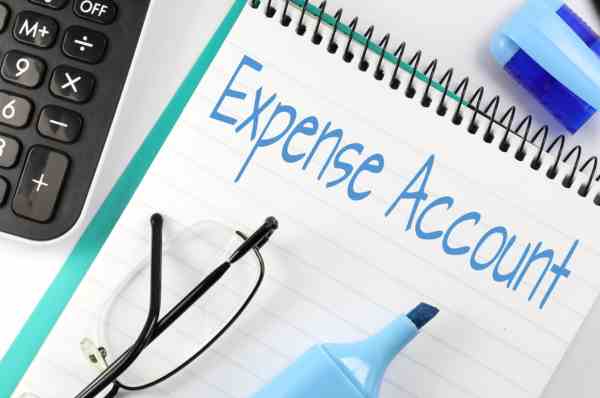Planning, evaluating, and documenting transactions are all parts of managing financial accounts. An expense account is among the numerous types of accounts you will need to handle. You can efficiently manage your finances, or at the very least, know where they are going, if you understand what an expense account is and why your business needs one. There are numerous types of expenses to keep track of, and in this post, we’ll a take a list of them so you can learn more about the expense account.
Expense Account
An expense account is a record that keeps track of and also organizes various expenses your company incurs over time. It contains funds in which the employer gives access to the employee for work- related issues. Every new period regardless of it being weekly, monthly or yearly indicates a new expense account because expense accounts are temporary accounts. In an expense account expenses increase by debit and decreases by credits in an expense account.
An expense account helps you see how much you spent on all of your expenses, including payroll and advertising. You can divide your expense account into more manageable subaccounts to reduce the risk of inputting errors. By doing so, you may better manage your finances, keep track of your spending, and stay organized.
Each sub-account amount in your expenditure account should be listed together with the overall expense balance. The expense account is one of the five primary accounts you need to track.
What Is the Purpose of an Expense Account?
There are many reasons why an expense account is important for your corporation. The main purpose of expense account is to keep track of the business spending. Others include:
You can maintain your legality by separating your expenses. it can prevent combining deductible and non-deductible expenses by categorizing the quantities of your expenses. The IRS can become suspicious if you exclude non-deductible expenses from your taxable income.
An expense account is essential for maintaining organization and assisting with budgeting. You can better determine which costs are ongoing and which are one-time when you break down your company’s expenses. In this manner, you may forecast future costs when making your budget.
Spending money on items you don’t need is simple. You may readily compare your outgoing and incoming cash flow if you have an expense account. You may also track where all of your money is going by breaking down your costs into separate accounts.
An expense account can help,
- To review.
- Keep you compliant.
- Show you where all of your money is going, and assist you in eliminating wasteful spending.
- Be practical for comparing expenses to income and aid in creating a budget for future costs.
Expense Account List
An expense account list comprises of different expenses every business compiles in a certain amount of time. These are also expenses essential for the business to be productive and expand. They include:
- Cost of Goods Sold (COGS).
- Promotion.
- Salaries, benefits, and wages.
- Selling, general, and administrative (SG&A).
- Rent and insurance.
- Depreciation and amortization.
- Interest.
- Taxes.
- Impairment charges.
- Rent.
- Salaries, benefits, and wages.
- Transaction fees.
- Commissions.
- Marketing and advertising.
Expense Account Examples
Examples of expense account include:
#1. Employee Wages and Benefits
Employee wages and benefits refers to the cost that your businesses incur to pay hourly employees. The line item may also include them in addition to payroll taxes and employee perks. In the income statement’s expenditure section, a wage expense could be listed as a line item. This expense falls under the category of variable costs.
#2. Advertising
An advertising expense describes the costs associated with promoting a business through channels like billboards, fliers, radio, television, the Internet, and periodicals (newspapers and magazines). It is a list under operating expenses on the income statement.
#3. Inventory and Equipment Purchases
These are raw materials used in production and finished commodities that are offered for sale. They are examples of expense account.
#4. Rent
Rent includes the renting of a property during a period. It is recorded in the expense account. After the cost of goods sold and compensation expense, this expense is one of the bigger ones that the majority of business report.
#5. Utilities
Utility expenses includes the cost of using utilities like power, water, waste removal, heating, and sewage.
Expense Account Debit or Credit
An expense account keeps track of all transactions in owners’ equity brought on by the usage of assets or rising liabilities when providing products or services to clients. It accounts for all business expenses, including those for bad debts, water, telephone, fuel, salaries, electricity, repairs, wages, depreciation, interest, stationery, entertainment, honoraria, rent, and utilities, among other costs of doing business.
The expense account aids the organization in managing and planning its varied business expenses over a predetermined period of time. So that one can clearly see where money is going and arrange the finances accordingly, this account can be divided into sub-accounts. The expense account appears on the company’s profit and loss statement and is used to record information about various sorts of expenditures in accounting records.
Every business requires credits and debits to balance its accounting. Credits help to lower an expense account while raising revenue, equity, or liabilities. While credits raise liability, equity, or income accounts, debits increase expense or asset accounts.
The figures are entered into two accounts, the debit and credit columns when accounting for company transactions. Therefore, being aware of the distinction between debits and credits will help one balance their books by ensuring they know whether an item should be credited or debited.
Is an Expense a Credit or Debit?
Typically, the expense account contains debit balances and grows when a debit entry is made. The balances of an expenditure account will therefore be on the left side of a T-account. In other words, an expense will naturally balance as a debit rather than a credit. This also means to debut the positive expense values while also crediting the negative balances.
Why an Expense Is a Debit Instead of a Credit
Remember that whereas debits serve to reduce liability, equity, or revenue accounts while increasing expense or asset accounts, credits serve to raise revenue accounts, equity, or liability. Due to the fact that expenses reduce the owner’s equity, they should result in a debit balance. Furthermore, an expense must be recorded as a debit because the owner’s equity balance is often a credit balance.
At the end of the accounting year, the debit balances in the expense account will be closed and moved to the owner’s capital account, lowering the owner’s equity.
The majority of the accounts utilized in the general ledger are expense accounts. This kind of transient account is zeroed out at the conclusion of the fiscal year. At the end of the fiscal year, it is zero to allow room for the recording of a fresh set of expenses in the following year.
This indicates that the expense accounts are temporary—existing just for a month, quarter, or year—before being replaced by fresh accounts for each succeeding period. The account is regarded as transitory as a result. A company’s expense account increases when money is spent (a debit), and it lowers when money is credited from another account into the expense account.
What Are the Types of Expense Accounts?
There are several types of expenses, including:
- Operating and non-operating expenses.
- Variable and fixed expenses.
- Deductible and non-deductible expenses.
#1. Operating and Non-operating Expenses
Operating expenses include costs associated with your company’s primary operations, such as the cost of goods sold (COGS). Non-operating costs, on the other hand, include things like the interest on business loans and are not directly related to operating activities.
#2. Fixed and Variable Expenses.
The costs you can incur while operating your firm can also be divided into two categories: Rent is an example of a fixed cost that doesn’t change no matter how much you sell. Direct labour is an example of a variable expense that changes depending on how much you sell. Remember that your operating expenses are a combination of fixed and variable expenses.
#3. Deductible and Non-deductible Expenses.
Expenses that can be deducted from your business’s taxable income in order to lower your tax burden are considered to be deductible business expenses. This is one of the main benefits of keeping track of your spending. Additionally, bear in mind that deductible expenses may be deducted in full or in part.
What Is Not an Expense Account?
An expense account is not the same as a savings account. You keep track of your costs using an expense account. This can be advantageous if you need to stick to a budget or try to save money.
What Are the 5 Basic Accounts?
Accounting has crucial importance in maintaining financial stability. That is why recording all transactions ongoing in your business is a worthwhile task. There are five basic accounts that can fulfil this need. They include:
#1. Expense Account
An expense account is just “a running tally of your business expenses for each period.” The expense accounts have the daily operating costs for the company.
#2. Income Account
An income account is the summary of the company’s gross revenue or the volume of sales for a specific time period. This is what the company has made over a period of time.
#3. Asset Account
It is an account that has a list of the company’s assets. A corporation records all the assets it has in the asset account without taking into account its losses or sums owing.
#4. Liability Account
This account contains unpaid obligations that your business owns. This also can be offset by its assets.
#5. Capital Accounts
This is an account which has the record of the ownership stake (equity) that the owners, or shareholders, have in the business. It simply shows what the business owner owns and what they don’t.
Your general ledger is the information centre that keeps track of each financial transaction your business does, and it contains five different accounts.
What Are the Rules of Expense Account?
An expense account has a law that states to debit all expenses and losses and credit all income and gains.
This means that to increase an expense account, it must be debited. To decrease an expense account, it must be credited. The normal expense account balance is a debit.
It is important to remember the accounting formula, Assets = Liabilities + Equity, in order to comprehend why there is always a need to debit expenses. Due to the fact that equity is defined as common stock plus retained earnings and retained earnings are defined as revenues fewer expenses and dividends, expenses appear under the equity side of the calculation. Since expense accounts are close at the conclusion of the term, they are regarded as temporary accounts in this equation. Expenses must be debited since they reduce the owner’s equity credit balance.
Is Rent an Expense Account?
Rent is an example of an expense account. A business must record its rental charge on the income statement just like any other expense.
In Conclusion,
The expense account holds an important role in making a financial budget. Keeping track of your spending requires keeping track of your monthly purchases. It’s a necessary task that you should ideally complete.
FAQs
Where can I find the expense account?
The profit and loss account of the company shows expense accounts.
What are expenses on a balance sheet?
Expense is the monthly payments your business makes to fund operations. Expenses are in some ways a subset of your obligations because it is usually used to monitor the financial health of your company.
What is the difference between a cost and an expense?
Cost and expense are distinct terms because cost designates an outlay while expense refers to the amount of money one needs to purchase items.
Related Articles
- WHAT IS AN EXPENSE RATIO AND HOW DOES IT WORK?
- EXPENSE MANAGEMENT TOOLS: Step by Step Guide and Best Tools to Use
- HOUSING EXPENSE RATIO: What It & How To Calculate it
- BUSINESS EXPENSE CATEGORIES: Best 2023 Business Expense Categories to Consider
- EXPENSE REPORT: Meaning, Software & How to Fill Out






